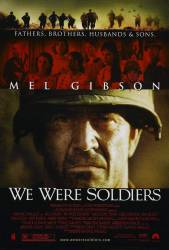Question: Would a sergeant-major participate in a mission?
Question: The early versions of the M16 had severe problems with jamming. There may have been several causes; instructions issued that the rifle was "self-cleaning", improper ammunition design, improper magazine design (therefore in a later stage 18 rounds instead of 20 were used in the mag). It is not necessarily a mistake, certainly not by the filmmaker, but there are several writers mentioning serious casualties amongst fighting troops specifically because of jamming M16 rifles. Why does this book/film not even include a hint of that problem which surely must have existed at that time and place?
Chosen answer: There is no definitive information on this topic, and although factually accurate, a technical problem with a weapon was probably not enough to build an entire sub-plot, and would not hold the interest of the moviegoer. There were enough casualties without having to take into consideration weapon malfunction.
Answer: The M16's used in this battle were second generation M16A1's easily distinguished by the forward bolt assist on the right hand side of the rifle. The original M16 had no bolt assist and the jamming was caused by a different propellant that made the weapon very dirty.
Question: What does the term "Fire in the hole" mean? It is used in this and many other military films.
Answer: It was originally a mining term. A hole was drilled in a seam and then dynamite pushed into it. As an explosion in a mine is always dangerous, the other miners were warned that there was "fire in the hole". It's since been adopted for most other situations involving explosives.
Question: An entry on the wearing of full combat gear and arms on the transport to 'Nam has been corrected, reason being that this is done today. This is correct, as rapid deployment in zones with little or nonexistent local military infrastructure exists requires every soldier to be operational when hitting ground. But was this the case at the time in Vietnam? Sure, this is early in the war, before a full scale upbuild but were incoming troops really transported this way, even in '65?
Chosen answer: Yes and no. This has been done on and off since the 101st Airborned dropped on D-Day. Mainly it depends on the area being travelled through and the destination.
Question: The request "Fire for effect." is used in this and many other war films when calling in artillery support. What is the meaning of this term?
Answer: After a series of individual rounds are fired to insure that the artillery is on target, the entire battery then fires as many rounds as possible to have the greatest effect on the enemy.
Question: One of the deleted scenes has a young soldier relating a story about one of his tough old SNCOs who was terrified of Plumley. This tough old Sergeant arrives on parade naked except for two Medals of Honor. Is this possible? As far as I can work out the last dual recipients were during WW1 - posthumously.
Chosen answer: Smedley Butler and Daniel Daly. Both were awarded the medal of honor twice, and lived to tell about it. Both were also U.S. Marines. More info here at http://www.grunts.net/legends/butler.html and http://www.cmohs.org/recipients/double.htm.






Answer: This one did, everything ascribed to him in the film was true.
Farmersboy
CSM Plumley's records show that he served in 320th Glider Field Artillery Battalion as a scout. The 320th participated in two glider assaults in the European Theater. Also, Plumley never served in Korea during the Korean War, so he couldn't have participated in one of the two combat jumps of that conflict. His record book indicates he was at Ft. Campbell, Kentucky (1951 to early 1953) when he received orders to Germany. Finally, he never claimed to have made any combat jumps in his career.